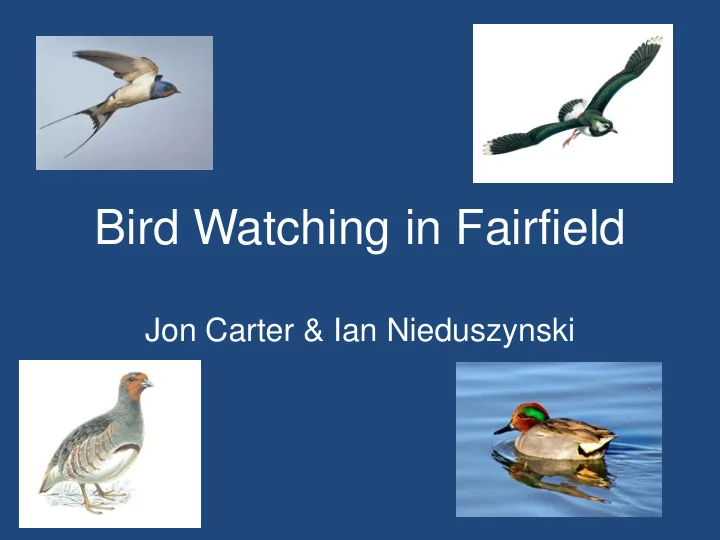

Bird Watching in Fairfield Jon Carter & Ian Nieduszynski
Bird Habitat Birds may be categorised by their habitats, which provide them with food and shelter. The normal classification is:- Woodland √ Farmland √ Wetland √ Upland − Coastal − Some upland breeding birds over-winter in Fairfield.
Marshy land Orchard Wet Cattle pasture grazing Woods Ponds Hay Arable meadow
Winter Visitors – Flocking Thrushes Fieldfare are mostly of Scandinavian/Russian origin. They are the same size as Mistle thrushes, but have a grey head. Redwing are small like Song thrushes, but have a strong superciliary eye-stripe and a red underwing.
Fieldfare in Willow tree (9/11/2014) Redwing next to Pony Wood (2/3/2015)
‘Our’ Thrushes Mistle Thrush Song Thrush in Cherry Tree
Snipe Snipe are medium sized wading birds with short legs and long straight bills. 90% of those in the UK are from abroad. They are upland breeding birds that over-winter here and we have 70-105 here between September and March/April.
Overwintering Here Snipe Jack Snipe Woodcock
Finches - Linnet A small, slim finch, that feeds on seeds and insects. Males are attractively marked with crimson foreheads and breasts. They have an undulating flight, usually twittering as they fly and may be seen in large flocks during the winter. Pony Wood (30/1/2015)
Linnets We’ve had as many as ~120 linnets in Fairfield around the Pony and Little Wood areas. It is our use of bird-friendly mix around the arable crop that has sustained them!
Birds of Spring and Summer In Spring birds have gained their breeding plumage and are generally easier to identify. Many will be coming to nest here from Africa (e.g. Swallows, House Martins, Swifts, Chiffchaff, Willow Warblers). Others may be passing through on longer journeys and treating Fairfield as a service station (e.g. Wheatear)!
Out of Africa Most warblers Equator Swifts Swallows
Swallows, Swifts and House Martins Swallow Swift House Martin Apr-Oct May - Sept Apr-Oct
Swallows Migrating swallows cover 200 miles a day, mainly during daylight, at speeds of 17-22 miles per hour. Total journey 5,500 miles. • 50% of adults don’t return • 80% of juveniles don’t return
Warblers Warblers are insectivorous, and most come here from Africa for Spring and Summer. Chiffchaff Willow Warbler
More Warblers Blackcap (Lesser) Whitethroat
Wheatears These handsome birds winter in sub-Saharan Africa and migrate huge distances either NW to Canada or NE to Alaska. In spring last year we had two dozen in Fairfield, presumably Canada-bound!
Birds that may Nest here There are several red-listed target birds for Fairfield, that we should look out for! • Lapwing • Grey Partridge • Tree Sparrow • Starling
Lapwing Lapwing are ground-nesting birds that breed on wet pastures or farmland. They feed on insects, spiders and earthworms. Their prime habitat is a mosaic where grass and spring tillage fields are close together.
Lapwing Last year lapwings bred and there were two pair of chicks. This is a success story as lapwings have not bred here Lapwing in Arable for many years! Crop (5/6/2014)
Tree Sparrow Tree Sparrow House Sparrow Tree Sparrows have not nested in Fairfield, but a pair were in our garden Oct-Dec.
Grey Partridge The Grey partridge is a medium - sized, plump gamebird which is found in lowland arable areas. It feeds on seeds, shoots and leaves. They have declined greatly with agricultural intensification.
Grey Partridge in Fairfield Last year we had a pair of grey partridge nesting in the west field, but they did not seem to raise chicks. Last August we released 4 chicks into the arable field.
Other Birds we might See • Crows • Starlings • Sparrows • Finches • Buntings • Dabbling Ducks • Rails • Tits • Woodpeckers • Birds of Prey
Crows Magpie Jay Jackdaw Carrion Crow
Starling Slightly smaller than a blackbird and very social bird. Starling in Orchard
Dabbling Ducks Mallard (School Pond) Teal
Rails See it on School Pond Moorhen Coot See it near Lucy Water Rail Brook
Reed Bunting Reed buntings are predominantly farmland and wetland birds. They feed on insects in Summer and seeds the rest of the year. Male Reed Bunting in the Orchard (17/3/2015)
Finches Bullfinch Greenfinch Chaffinch
Goldfinch If you have not seen these, buy some binoculars! Goldfinch feeding on Birch catkins (15/2/2015)
Tits Great Tit Blue Tit Long-tailed Tit Coal Tit
Birds of Prey Buzzard Kestrel Male Sparrowhawk
Great Spotted Woodpecker You may hear it drumming!
THE END We end with a Little Owl that we would like to attract into Pony Wood!
Sparrows Tree Sparrow (6/11/2014)
Crows - Jay European Jay in Apple Tree (6/11/2014)
Crows - Jackdaw These birds live in our chimneys and say ‘ chack ’. Jackdaws in West Field
Crows - Magpies Magpie near School Pond
Recommend
More recommend